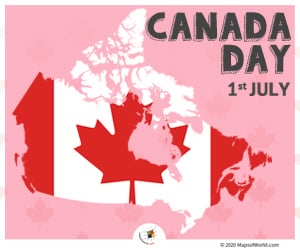

Canada Day is celebrated on July 1.
Located in the continent of Northern America, Canada is the second largest country of the world occupying an area of about 3,855,100 square miles (9,984,670 square kilometres). With an advanced economy, Canada is one of the most developed nations of the world. Canada Day, often referred to as the birthday of Canada, is celebrated on July 1. This is a commemoration of the signing of the British North America Act on July 1, 1867, with which Canada became a federation with its own independent constitution. Despite being a sovereign nation and a strong democracy (led by its Prime Minister), it remains a constitutional monarchy recognizing Elizabeth II as the Queen. It is also a member of the Commonwealth of Nation.
The earliest inhabitants of Canada are believed to have migrated to the country from Siberia some 14,000 years ago. By the time the Europeans arrived, there was a considerable presence of the indigenous tribes such as the Inuit, First Nations, and the Metis. Estimates suggest that the arrival of the Europeans led to the decline of the indigenous population by over 50%.
The earliest arrival of the Norse in Canada is dated back to about 1000 AD. In 1497, John Cabot claimed the Atlantic Coast for England, and in 1534 Jacques Cartier claimed the shores of Saint Lawrence River for France. This was the beginning of the establishment of New France, and subsequently the establishment of English rule in Canada.
The French and Indian War (1754-1763) and the Seven Years’ War (1756 – 1763) involved the two great European powers France and England in a bitter conflict. It resulted in Britain’s acquisition of French territories in the continent of North America. The Royal Proclamation of 1763 created the Province of Quebec and expanded Nova Scotia. The following century would precipitate the consolidation of nationalism in Canada. The American Revolutionary War (1775–1783) had already influenced Canadian thought and fueled anti-British sentiments.
The early part of the 1800s was a time of flux. Canada became the main war front in the war between the US and the UK in 1812. Immigration from Britain remained high but the need for a consolidated Canada and a government responsible for the welfare of the Canadians was felt. Next came the British North America Act, 1840 or the Act of Union of 1940, which abolished the separate legislatures of Upper Canada and Lower Canada and consolidated the different settlements into a single Province of Canada.
The British North America Act 1867, which is known in Canada as the Constitution Act 1867, created the legal framework for the creation of the Dominion of Canada with an independent government and legislature, setting up the country’s judicial and revenue systems. This act now comprises a large part of the Constitution of Canada. The passing of this act was celebrated on July 1, 1867. It is in commemoration of this day that Canada Day is celebrated on July 1 each year. This annual celebration was established when the day was designated Dominion Day in 1879 (renamed Canada Day in 1982).
Within the next decade, the acquisition of the Hudson’s Bay Company holdings and the provinces of Manitoba and Prince Edward Island expanded the Canadian federation. The foreign affairs of Canada were still controlled by Britain and this involved Canada in World War I. By the end of the war, however, Canadian independence was sealed by its membership in the League of Nations, independent of Britain. In 1931, Canada’s independence was affirmed by the Statute of Westminster.
Related Links:
The Republic of Madagascar is an island country located in the Indian Ocean, off the…
The Euro is the official currency of the European Union. It is, however, not incumbent…
There are many countries or regions that are partially recognized by the UN, have disputes…
The Alaska Statehood Act was signed into law by President Dwight D. Eisenhower in 1958,…
The name Persia may, however, only be used to refer to Iran in some contexts.…
Hawaii is an Island State in the US. It is one of the 50 states…